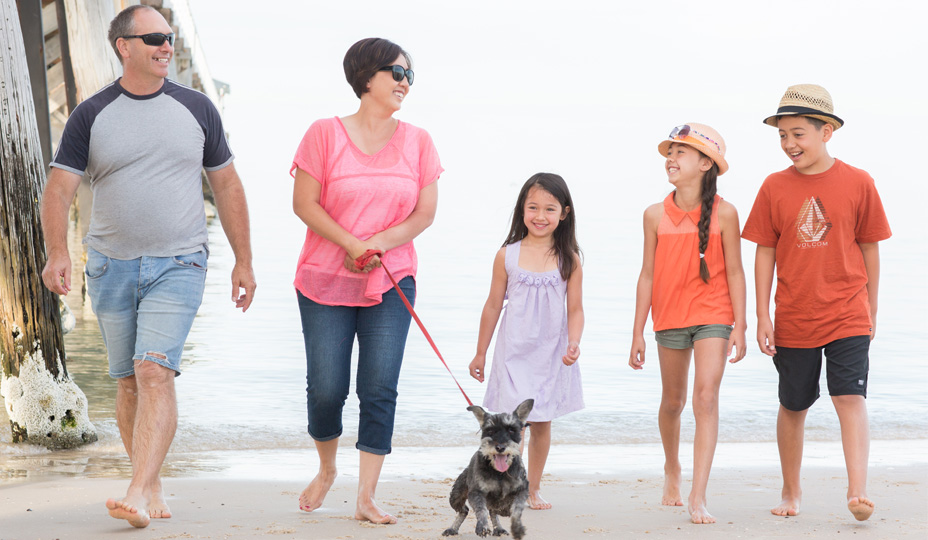
It seemed the most unlikely thing, that at 39 I would have a stroke while helping my four year old daughter clean up Lego in her room. I remember standing up and putting my left hand on the door and realising I couldn’t feel it, and then I lost all feeling in my left side as well.
I was in hospital for two days before they found the torn artery in my brain that led them to a stroke diagnosis. I laid there, with paralysis down my left side, in agony waiting to learn what was wrong. This time and the subsequent loss of my license and independence have been the most challenging in my life. I am not one to give up though and I am proud to say I pushed myself to get my license returned within three months!
There were no warning signs. I was a fit, healthy young professional with three young children. It certainly changed my life and I realised that it can happen to anyone.
At the time I didn’t know that every 10 minutes an Australian has a stroke or that there are hundreds of thousands of survivors who need ongoing therapy that is often exhausting and painful.
The inability to use my left hand can be distressing at times. You realise how much meaning small tasks like styling your daughters hair have when you lose the ability. Throughout the first two years of rehabilitation I focused on one goal - I wanted the ability to do my daughters hair again.
Rehab is extremely hard work and sometimes this goal of mine has felt harder and harder to reach. But since meeting Associate Professor Susan Hillier at UniSA this feeling has started to change. With her therapy I have found inspiration to keep fighting, even on the hardest days.
By writing about my experience I hope to inspire people to visit Susan’s crowdfunding campaign to kick-start an important clinical trial that could help more stroke survivors like me.
One year ago Susan agreed to trial me on a new system called Proximity:Clinical that she is testing for stroke rehabilitation. It has presented one of the most exciting possibilities for my rehabilitation since my stroke.
The system uses real-time video technology that create a series of illusions to trick the brain into rewiring neural connections that have been lost due to damage.
In each session I use the mirror program. The unaffected half of my body is filmed and projected onto a large screen. Watching this image I then align the centre of my body to create a real-time picture of myself. As I raise my unencumbered right arm up over my head the figure on the screen fluidly raises both arms.
This process has made me realise that I am a visual person. The sensations that I feel in the paralysed sections of my body are simply amazing when I compare my progress with other forms of therapy. It is like suddenly my brain remembers what is required of it and I feel a warmth and tingling spread through parts of my left side as I try to move it to copy the image.
Since my stroke my arm has felt like one of those long fabric door stops hanging from around my neck but it is improving thanks to Susan and Proximity:Clinical. It could even allow stroke survivors to manage parts of their recovery at home.
I have been helping Susan by experimenting with an at home training program from the system and I made a discovery that has allowed Susan to make further progress. I realised when I was watching the video recordings that if I wore the same tshirt I was wearing in the video that my own practice improved. Such a simple thing yet my brain made an even greater connection with the images projected on the screen. This in turn led me to realise that the daily pain I experience was greatly reduced after the therapy.
While I am not there yet, I am determined to regain some of what I lost. I know I will never recover full dexterity but I know I will regain some control, which is so important as a stroke survivor.
Susan is seeking donations to run a more rigorous clinical trial of the program. Please consider making a donation as this project could lead to a massive re-think of stroke rehabilitation therapy.
Please visit www.chuffed.org/project/dance-technology-for-stroke-rehabilitation.
The University of South Australia has committed to boost donations by an extra 20% - but only if the project target of $40,000 is achieved, so please get behind this campaign and share it with your friends.

University of South Australia is crowd-funding to fund a cutting edge approach to rehabilitation therapy that uses illusions to retrain the brain. It could hold the answer therapists have been seeking to improve the quality of life of stroke survivors.
Big things can happen when we all work together. Crowdfunding@UniSA gives you the opportunity to engage directly with innovative research projects and follow their progress as our researchers work to tackle important issues. The first three projects open for your support aim to improve our health, society and the environment. For the campaigns that reach their targets, the University of South Australia has committed to boosting all funds raised by an extra 20% - so your dollar will have even greater impact.
